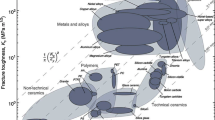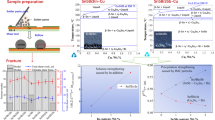Eutectic 63Sn-37Pb solder is a typical viscoplastic material widely used in aerospace applications. In order to benchmark the mechanical reliability of electronic packaging structures in harsh environments, this study focused on the constitutive behavior of the solder. A unified creep-plasticity constitutive model is proposed with an enriched flow rule to satisfactorily describe the plastic and hardening stages. The strain rate range of 10-4 and 10-2 s-1 and the temperature range of -55 and 125°C are covered by a series of comprehensive uniaxial tensile experiments. Moreover, the experimental results are analyzed to elucidate the underlying mechanism of the calibrated parameters. It is found that the drag strength increases with temperature, while its slope is reduced with the strain rate. The short range of back stress is closely associated with temperature to influence the hardening slope of the stress–strain relationships. The value of hardening exponent is sensitive to strain rate and thus determined to be 0.52 and 2.72 for the strain rate greater and less than 2·10-4 s-1, respectively. The strain rate and temperature ranges in this study are capable of covering the temperature cycling tests for reliability qualification of electronic devices. Thus, the proposed enhancement of the unified creep-plasticity constitutive model facilitates the finite element simulations of packaging structures under temperature cycling conditions. This framework of the proposed constitutive model is readily extended to other types of viscoplastic solders within wide strain rate and temperature ranges.





Similar content being viewed by others
References
S. Wang, Y. Yao, and X. Long, “Critical review of size effects on microstructure and mechanical properties of solder joints for electronic packaging,” Appl. Sci., 9, No. 2, 227 (2019), https://doi.org/10.3390/ app9020227.
X. Long, Y. Liu, F. Jia, et al., “Thermal fatigue life of Sn–3.0Ag–0.5Cu solder joint under temperature cycling coupled with electric current,” J. Mater. Sci.-Mater. El., 30, No. 8, 7654–7664 (2019).
X. Long, S. Wang, X. He, and Y. Yao, “Annealing optimization for tin-lead eutectic solder by constitutive experiment and simulation,” J. Mater. Res., 32, No. 16, 3089–3099 (2017).
X. Long, Y. Feng, and Y. Yao, “Cooling and annealing effect on indentation response of lead-free solder,” Int. J. Appl. Mech., 9, No. 4, 1750057 (2017), https://doi.org/10.1142/S1758825117500570.
N. Bai and X. Chen, “A new unified constitutive model with short- and long-range back stress for lead-free solders of Sn–3Ag–0.5Cu and Sn–0.7Cu,” Int. J. Plasticity, 25, No. 11, 2181–2203 (2009).
X. Chen, G. Chen, and M. Sakane, “Prediction of stress-strain relationship with an improved Anand constitutive model for lead-free solder Sn–3.5Ag,” IEEE T. Compon. Pack. T., 28, No. 1, 111–116 (2005).
X. Long, X. He, and Y. Yao, “An improved unified creep-plasticity model for SnAgCu solder under a wide range of strain rates,” J. Mater. Sci., 52, No. 10, 6120–6137 (2017).
X. Long, C. Du, Z. Li, et al., “Finite element analysis to the constitutive behavior of sintered silver nanoparticles under nanoindentation,” Int. J. Appl. Mech., 10, No. 10, 1850110 (2018), https://doi.org/10.1142/S1758825118501107.
X. Long, Z. Li, X. Lu, et al., “Mechanical behaviour of sintered silver nanoparticles reinforced by SiC microparticles,” Mater. Sci. Eng. A, 744, 406–414 (2019).
X. Long, W. Tang, Y. Feng, et al., “Strain rate sensitivity of sintered silver nanoparticles using rate-jump indentation,” Int. J. Mech. Sci., 140, 60–67 (2018).
G. Chen, X. Zhao, and H. Wu, “A critical review of constitutive models for solders in electronic packaging,” Adv. Mech. Eng., 9, No. 8 (2017), https://doi.org/10.1177/1687814017714976.
Y. Yao and L. M. Keer, “Cohesive fracture mechanics based numerical analysis to BGA packaging and lead free solders under drop impact,” Microelectron. Reliab., 53, No. 4, 629–637 (2013).
W. Wang, Y. Yao, X. Long, and Z. Zhu, “Material and structural optimization of fatigue life of PBGA under temperature cycling,” in: Proc. of the 19th Int. Conf. on Electronic Packaging Technology (ICEPT) (Aug. 8–11, 2018, Shanghai, China), IEEE (2018), pp. 477–481, https://doi.org/10.1109/ICEPT.2018.8480462.
S. Wen, L. A. Keer, S. Vaynman, and L. R. Lawson, “A constitutive model for a high lead solder,” IEEE T. Compon. Pack. T., 25, No. 1, 23–31 (2002).
X. Long, X. Zhang, W. Tang, et al., “Calibration of a constitutive model from tension and nanoindentation for lead-free solder,” Micromachines-Basel, 9, No. 11, 608 (2018), https://doi.org/10.3390/mi9110608.
D. K. Patel and S. R. Kalidindi, “Correlation of spherical nanoindentation stress-strain curves to simple compression stress-strain curves for elastic-plastic isotropic materials using finite element models,” Acta Mater., 112, 295–302 (2016).
Author information
Authors and Affiliations
Corresponding author
Additional information
Translated from Problemy Prochnosti, No. 6, pp. 126 – 136, November – December, 2019.
Rights and permissions
About this article
Cite this article
Wang, W.J., Long, X., Du, C.Y. et al. Enhancement of the Unified Constitutive Model for Viscoplastic Solders in Wide Strain Rate and Temperature Ranges. Strength Mater 51, 917–925 (2019). https://doi.org/10.1007/s11223-020-00142-5
Received:
Published:
Issue Date:
DOI: https://doi.org/10.1007/s11223-020-00142-5




